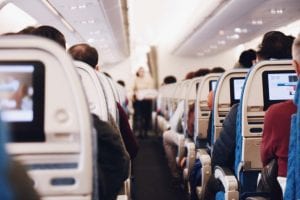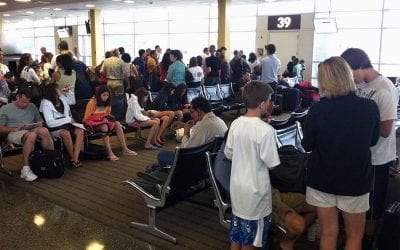Choosing aircraft seating for flight can make or break a flight, particularly if it’s long. Here are questions and tips to get the seat of your choice.

American Airlines A319 landing at Philadelphia International Airport. Copyright © 2018 NSL Photography. All Rights Reserved.
What aircraft seating you choose is a topic of continual discussion among travelers. What’s the best or worst seat? Is one seat safer than another? What seats will allow you to get up easily? Can you recline your seat? Will you really be able to sit with your family? How do you determine how good individual seats are on your flight?
I’ve got some answers for you, perhaps some that you don’t expect, and hacks to help you get the best aircraft seating or at least the seat type you want for your next flight.
The pros and cons of window, middle and aisle seats.
Window seats:
Window seats are the ones with outside views, plus the passenger there controls the window shade, to a point. Sometimes the flight crew overrides passenger window shade control by directive or locking switch. Window seats over the wing don’t have a view down. Window seats offer somewhat more privacy and fewer disturbances than other seats. You can lean against the wall to help you sleep.
Window seats have slightly less leg room and you have to get other passengers in your row to get up so you can go to the lavatory or grab something from your bag in the overhead bin. Window seats can feel claustrophobic.

In middle seats you’re generally hemmed in by passengers on both sides. It’s particularly bad when passengers don’t respect general etiquette that middle seat passengers control both arm rests. Like window seat passengers, they have to get past the aisle seat passenger to go to the lavatory, but also have to get up for the window seat passenger.
On the other hand (don’t laugh), if you’re “close” to a passenger on either side of you, you can lift the arm rest up and be closer.
Aisle seat:
For those who need to use the lavatory often, in an aisle seat, you can do it without disturbing others in your row, but you do have to get up to let them out. In the aisle seat it’s easy to get up and grab belongings from the overhead bin or stretch a bit. Aisle seats are less claustrophobic.
Aisle seat passengers are often jostled during boarding and the seats are pushed and pulled by passengers boarding after you’re seated.
Here’s what you need to know about bulkhead and exit row seating.
Bulkhead seats:
You’ll generally — but not always — have a bit of extra legroom in a bulkhead seat. You won’t have to worry about passengers reclining in front of you. Bulkhead rows near galleys and/or lavatories are often noisy. At take-off and landing, your belongings must go in the overhead bin, as there’s no seat in front.
Some bulkhead walls have bassinet hooks, particularly on international flights, so you might be next to crying/screaming babies.
Exit row seats:
Exit row seats almost always have more legroom. You can’t sit there with young children. Because they’re next to a door, exit row seats are generally colder than other seats. Some may not recline.
Here’s what you need to know about seat pitch and width, plus seat position from front to rear.

Seat pitch is the distance between a point on one seat and the same point on the seat in front of it. For tall passengers, while it’s not a direct measure of legroom, the smaller the pitch the less legroom you’ll have. Seat width is important for passengers with wider bodies, as in a narrow seat you may be uncomfortably pressing against the arm rests during the flight.
Seat position from front to rear in the cabin can have consequences to consider.
• During periods of turbulence, seats at the front of the plane will generally be more stable than seats at the rear. Noise levels in the cabin are somewhat better than behind the wings.
• The last row of economy seats generally have little or no recline.
• Seats near lavatories or galleys are usually more noisy than other seats and therefore poor for those who wish to sleep or read.
Airlines may require you to change seats.
Required seat change:
It hasn’t happened to me often, but when the airlines had to change plane types for my flight I was even moved once from first class to economy. Other reasons you might be moved are to fulfill contractual obligations to crew or give a seat to an air marshal. If you’re entitled to a refund, you’ll likely have to apply for it.
“Safer” seats (there are none), door plugs and family seating information.
Seat safety:
An analysis of the FAA’s aircraft accident database for flights with seating information for survivors and those who died, between 1985 and 2000, indicate that seats in the back of the aircraft were slightly safer. The survivability rate for the back of the plane was 32 percent; the middle, 39 percent; and the front, 38 percent. That said, passenger survival in each accident had more to do with the accidents’ circumstances than the seats passengers were in. As a result, the FAA and aircraft experts say there is no “safest” seat on a plane.
Door plugs:
Recently, you’ve probably been aware that a door plug blew out on Alaska Airlines flight 1282. That’s led to the question, “Can you avoid sitting next to a plugged door on an aircraft?” Right now, unless you’re especially familiar with the aircraft on which you’ll fly, you won’t be able to know in advance what seats are beside a door plug. Perhaps in the future, some aircraft seating maps will denote door plugs, but the maps don’t show it now. More importantly, generally door plugs don’t make planes unsafe. Planes have been flying with them for years and with new inspection requirements they shouldn’t be a problem.
Family seating:
Most airlines are now seating families together, if at all possible, when they have young teens or younger children. Some are blocking out seating areas for families at least until reservations are too numerous to do so. Airlines are allowing families to move or be rebooked if necessary, to sit together, without charge. Each airline has specific requirements that must be followed to get family seating. Booking early, if at all possible, will help families ensure they sit together, as not all requests will be able to be accommodated, even with the new airline policies to do so.
Here’s how to find out how good your aircraft seating choice would be and how to get the seat you want.
To determine how good seats are:
Use Seat Guru to ascertain the quality of each seat on your flight. Make an informed seat choice. Seat Guru is the best seat map website and smartphone app available today.
The most important actions passengers should take to get the aircraft seating desired:
• Book early — The earlier you book your flight, the more likely you’ll be able to get the seat you want and select it.
• Get frequent flier status — Frequent flier status will generally open all seats for your reservation and will typically knock out fees for premium seats in economy. The higher your status, the more likely you’ll get a seat upgrade.
• Purchase a better seat — If you want more legroom and wider seats consider moving out of economy to premium economy, business or first class.

Particularly for long flights, understanding the pros and cons of aircraft seating can help you have the best flight possible. Once you determine the type of seat you need, use seat map software to be sure your choice will meet that need, then book it.
READ ALSO
Don’t forget passengers in the debate over modernizing the DCA perimeter rule
DOT and Congress should educate travelers about their rights to compensation
After many years working in corporate America as a chemical engineer, executive and eventually CFO of a multinational manufacturer, Ned founded a tech consulting company and later restarted NSL Photography, his photography business. Before entering the corporate world, Ned worked as a Public Health Engineer for the Philadelphia Department of Public Health. As a well known corporate, travel and wildlife photographer, Ned travels the world writing about travel and photography, as well as running photography workshops, seminars and photowalks. Visit Ned’s Photography Blog and Galleries.



